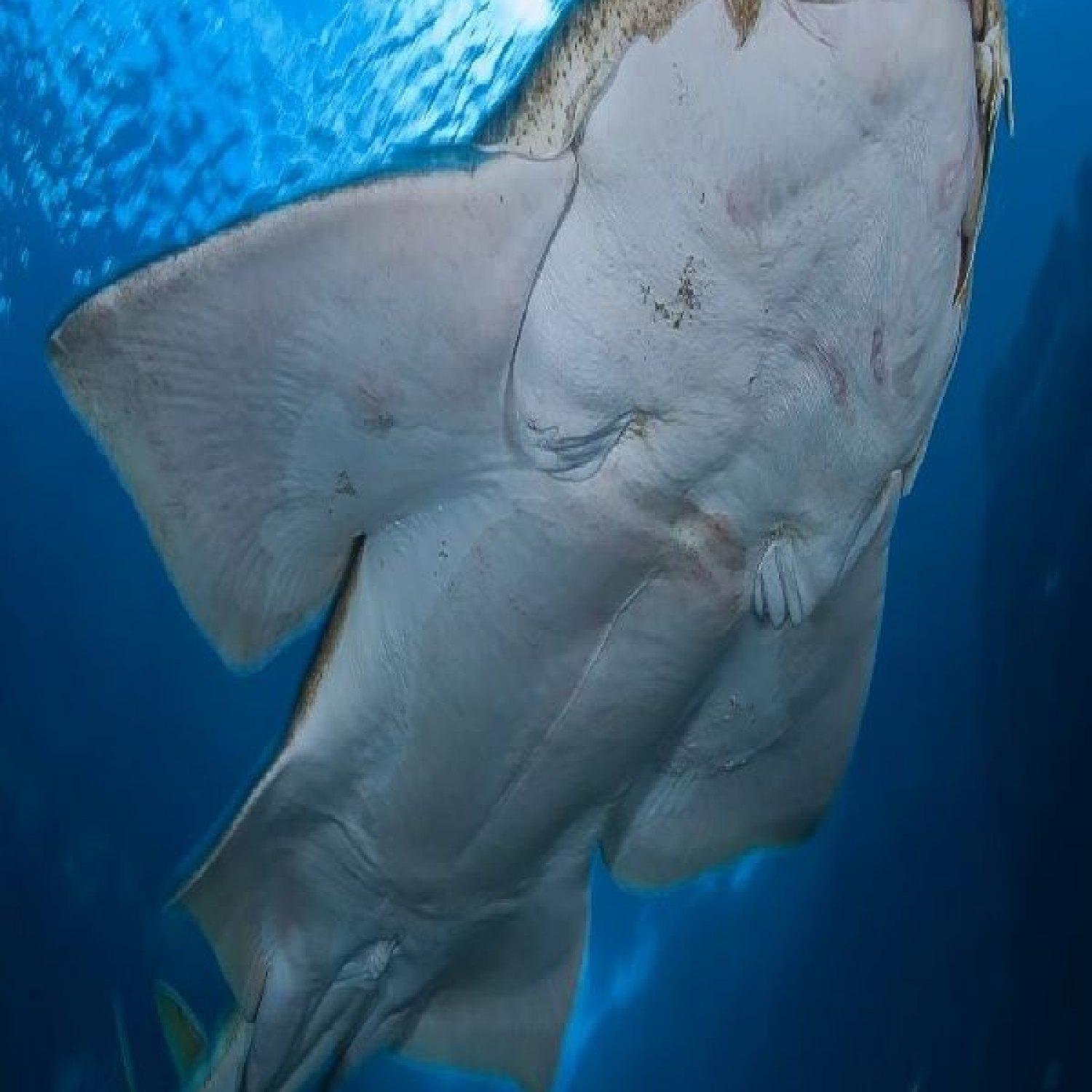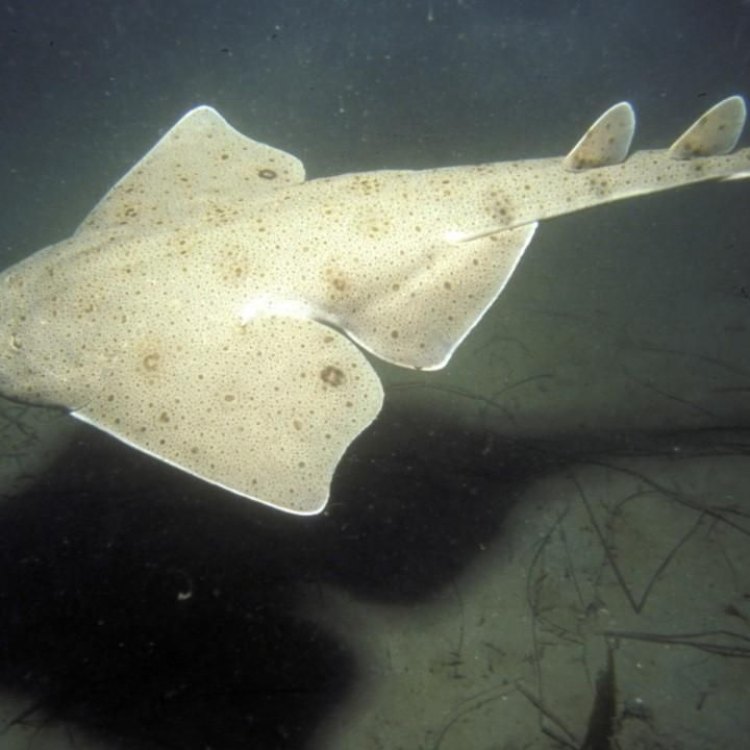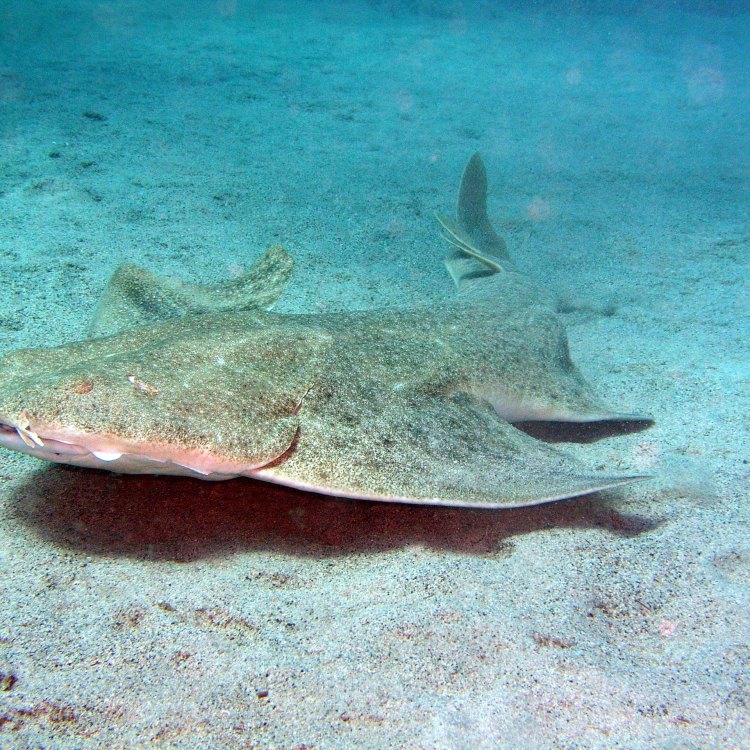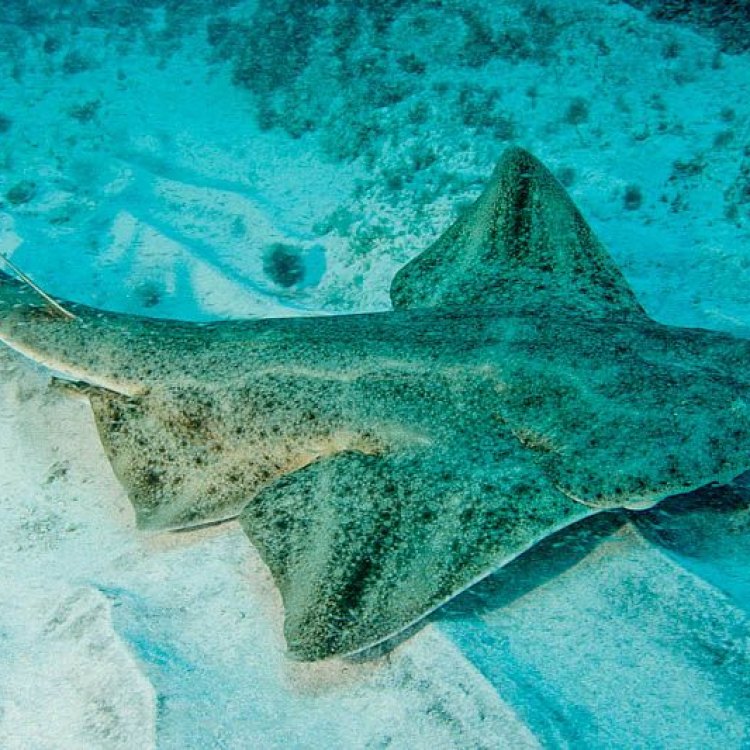
Angelshark
Up to 2.4 meters
Angelsharks are fascinating creatures found in the ocean, belonging to the Squatinidae family. They can grow up to 2.4 meters in length and have a flat, broad body with large pectoral fins. These gentle animals are often called 'monkfish' due to their monk-like appearance. Spotting an Angelshark in the wild is a rare treat, so keep your eyes peeled next time you're on a beach vacation. #Angelshark #Squatinidae #OceanLife #Monkfish
Animal Details Summary:
Common Name: Angelshark
Kingdom: Animalia
Habitat: Coastal waters
The Angelshark: An Elusive and Mysterious Creature of the Seas
The ocean is a vast and mysterious world, filled with a diverse array of creatures. From the tiniest plankton to the largest whales, the ocean is teeming with life. Among these creatures is the Angelshark, a unique and fascinating species that has captured the attention of scientists and ocean enthusiasts alike. In this article, we will delve into the world of the Angelshark, uncovering its incredible features and shedding light on its elusive existence Angelshark.The Angelshark, scientifically known as Squatina squatina, is a member of the Chondrichthyes class, also known as cartilaginous fish. It belongs to the order Squatiniformes and the family Squatinidae. Its scientific name, Squatina squatina, is derived from the Latin word "squatina," which means a kind of shark, and is a reference to its shark-like appearance.
Commonly referred to as Angelsharks, these creatures can be found in the northeastern Atlantic Ocean and the Mediterranean Sea. They have also been sighted in the North Sea and the Adriatic Sea. However, due to their elusive nature, their exact geographical distribution is still not fully understood.
One of the most striking features of the Angelshark is its flat and broad body shape. It has been described as a flattened ray-like shark that can grow to a length of up to 2.4 meters, making it one of the largest species in the family Squatinidae Albino Corn Snake. Its body is covered in a unique grey or brown coloration with a mottled pattern, making it perfectly camouflaged on the ocean floor.
Speaking of the ocean floor, that is where you are most likely to find the Angelshark. These creatures are known to inhabit shallow coastal waters, making their homes on sandy or gravelly seabeds. They have also been found in estuaries and lagoons, but they are rarely seen in deeper waters.
So, what is life like for an Angelshark? These creatures are ambush predators, meaning they lay in wait for their prey and then pounce on them in an instant. With their broad bodies and large pectoral fins, they can easily blend in with the ocean floor and surprise their unsuspecting prey, which includes fish, crustaceans, and mollusks.
Despite their large size and predatory nature, Angelsharks are not a threat to humans. In fact, they are known to be gentle creatures and are not aggressive unless provoked. They are also not commonly seen by humans, as they spend most of their time lying still on the ocean floor, waiting for their next meal to swim by.
The Angelshark is listed as "Critically Endangered" on the International Union for Conservation of Nature (IUCN) Red List of Threatened Species. This is due to various threats that they face, including overfishing, habitat destruction, and accidental capture in fishing gear. Their slow reproductive rate also makes it difficult for their populations to recover from these threats.
One of the most significant challenges in conserving this species is the lack of information and research on the Angelshark. Due to their elusive nature and preference for deeper waters, they are challenging to study. This has led to a limited understanding of their biology and behavior, hindering conservation efforts.
However, there is hope for the Angelshark. In recent years, there have been increased efforts to study and conserve this species. One such effort is the Angel Shark Project, a partnership between the Zoological Society of London (ZSL) and the University of Las Palmas de Gran Canaria. This project aims to gather information on the Angelshark's biology and behavior, as well as raising awareness about their endangered status.
One of the most exciting findings from the Angel Shark Project is the rediscovery of Angelsharks in the Canary Islands. This population was thought to have been extirpated due to overfishing, but in-depth surveys and studies conducted by the project revealed that they still exist in the area.
Unfortunately, despite these recent discoveries, the Angelshark remains critically endangered, and there is still a long way to go in terms of conservation efforts. It is crucial to continue studying and monitoring this species to gain a better understanding of their populations, movements, and behaviors.
Apart from their physical features and conservation status, there is still so much we don't know about Angelsharks. For instance, their mating and reproductive behaviors, as well as their lifespan, are still a mystery. Moreover, their exact country of origin and location within the Northeastern Atlantic Ocean and Mediterranean Sea remain unknown.
The mystery and elusive nature of the Angelshark make it one of the most intriguing creatures of the seas. Its flat and broad body shape, unique coloration, and ambush hunting strategy make it stand out in the shark world. However, it is also these very characteristics that make it challenging to study and conserve.
For now, the Angelshark remains a creature shrouded in mystery, with much left to be discovered. It is our responsibility to ensure that it remains a part of our ocean's diverse ecosystem for future generations to marvel at. The Angelshark's conservation is not just about preserving a species; it is also about preserving the balance of our planet's delicate marine environment.

Angelshark
Animal Details Angelshark - Scientific Name: Squatina squatina
- Category: Animals A
- Scientific Name: Squatina squatina
- Common Name: Angelshark
- Kingdom: Animalia
- Phylum: Chordata
- Class: Chondrichthyes
- Order: Squatiniformes
- Family: Squatinidae
- Habitat: Coastal waters
- Feeding Method: Ambush predator
- Geographical Distribution: Northeastern Atlantic Ocean and Mediterranean Sea
- Country of Origin:
- Location:
- Animal Coloration: Grey or brown with mottled pattern
- Body Shape: Flat and broad with large pectoral fins
- Length: Up to 2.4 meters

Angelshark
- Adult Size: 1.5 to 2.4 meters
- Average Lifespan: 25 years
- Reproduction: Ovoviviparous
- Reproductive Behavior: Mating occurs in shallow coastal areas
- Sound or Call: Unknown
- Migration Pattern: Unknown
- Social Groups: Solitary
- Behavior: Lies buried in the sand or mud
- Threats: Habitat loss, fishing, and accidental bycatch
- Conservation Status: Critically Endangered
- Impact on Ecosystem: Regulates prey populations
- Human Use: Commercial fishing, aquarium trade
- Distinctive Features: Flat body, camouflaged coloration, and upwardly-curved pectoral fins
- Interesting Facts: Angelsharks have a unique method of burying themselves in the sand or mud to ambush prey.
- Predator: Sharks and larger predatory fish

Squatina squatina
The Angelshark: A Unique Predator of the Deep
If you were to imagine a shark, it's likely that the first image that comes to mind is that of a fierce and sleek apex predator, darting through the ocean with sharp teeth ready to attack its prey. However, there is one shark that defies this stereotype and has adapted to a very different lifestyle - the Angelshark.Often referred to as the "flat shark", the Angelshark (Squatina squatina) is a member of the Squatinidae family and is the only species in its genus. They are found in the eastern Atlantic Ocean, from Norway to the Mediterranean Sea, and the western Mediterranean Sea PeaceOfAnimals.Com. In recent years, they have also been reported off the coasts of the United Kingdom and Ireland. Let's dive deeper into this fascinating creature and uncover its unique features, behavior, and impact on their ecosystem.
Physical Characteristics
The Angelshark has a distinctive appearance that sets it apart from other sharks. They have a flattened body, with a broad and pointed snout, and a pair of upwardly-curved pectoral fins that resemble the wings of an angel - hence their name. These pectoral fins are used to "fly" through the water, allowing the shark to move gracefully along the ocean floor. They also have a camouflaged coloration, making them almost invisible on the sandy or muddy ocean floor.Adult Angelsharks can reach an average length of 1.5 to 2.4 meters and weigh up to 90 kg Australian Bulldog. They have a lifespan of around 25 years, making them one of the longest-lived shark species. Interestingly, they start out as a grey-brown color and gradually become darker and more spotted as they age.
Behavior and Reproduction
Angelsharks are solitary creatures and can be found lying buried in the sand or mud, waiting for their next meal. This unique behavior, called "lurking", allows them to ambush unsuspecting prey, such as fish, crustaceans, and mollusks. They have a unique way of burying themselves in the sand or mud, with just their eyes and the tip of their snout exposed, making them almost impossible to spot.When it comes to reproduction, Angelsharks are ovoviviparous, meaning that the embryos develop within eggs inside the female's body until they are ready to hatch. After a gestation period of 9 to 12 months, the female gives birth to 8 to 25 live pups. Unlike other shark species, they do not have a definitive mating season, and it is believed that mating occurs in shallow coastal areas.
Conservation Status and Threats
Unfortunately, the Angelshark population has declined significantly in recent years, and they are now listed as Critically Endangered on the IUCN Red List of Threatened Species. One of the main reasons for this decline is due to habitat loss, as they prefer sandy and muddy areas close to shore, which are often affected by coastal development. Additionally, they are often caught as bycatch in commercial fishing gear, and their slow growth and reproductive rate make it difficult for their populations to recover.Impact on Ecosystem
Despite their elusive nature, Angelsharks play a crucial role in their ecosystem. As a top predator, they help to regulate the populations of their prey, preventing any one species from becoming dominant. This, in turn, helps to maintain a healthy balance within the ocean's food web.Human Use and Interesting Facts
While Angelsharks are not targeted by fisheries, they are often caught as bycatch in bottom trawl and gillnet fisheries. In some areas, they are also targeted for their fins, which are considered a delicacy in some cultures and used in soups. They are also occasionally kept in aquariums, but their large size and specialized diet make them challenging to care for in captivity.One of the most interesting facts about Angelsharks is their unique hunting technique. As mentioned earlier, they bury themselves in the sand or mud, and when their prey swims above them, they quickly strike with their sharp teeth, often swallowing their prey whole. This method of hunting is not seen in any other shark species, making the Angelshark truly one of a kind.
Predators
Despite their flat and camouflaged appearance, Angelsharks are still preyed upon by larger sharks and predatory fish. Their flattened shape and ability to bury themselves in the sand may protect them from some predators, but they are not immune to all threats.In Conclusion
In conclusion, the Angelshark is a unique and fascinating creature that has adapted to a specialized way of life. From their flat and camouflaged appearance to their lurking behavior, they are truly one of a kind in the shark world. Despite their critically endangered status, there is still hope for the conservation of this species through continued efforts to protect their habitat and reduce bycatch. As we continue to learn more about the Angelshark, let us also work towards preserving and protecting this iconic and mysterious creature of the deep.

The Angelshark: An Elusive and Mysterious Creature of the Seas
Disclaimer: The content provided is for informational purposes only. We cannot guarantee the accuracy of the information on this page 100%. All information provided here may change without prior notice.












